- Function File:
n =ellipord(wp, ws, rp, rs)¶ - Function File:
n =ellipord([wp1, wp2], [ws1, ws2], rp, rs)¶ - Function File:
n =ellipord([wp1, wp2], [ws1, ws2], rp, rs, "s")¶ - Function File:
[n, wc] =ellipord(…)¶ Compute the minimum filter order of an elliptic filter with the desired response characteristics. The filter frequency band edges are specified by the passband frequency wp and stopband frequency ws. Frequencies are normalized to the Nyquist frequency in the range [0,1]. rp is the allowable passband ripple measured in decibels, and rs is the minimum attenuation in the stop band, also in decibels. The output arguments n and wc can be given as inputs to
ellip.If wp and ws are scalars, then wp is the passband cutoff frequency and ws is the stopband edge frequency. If ws is greater than wp, the filter is a low-pass filter. If wp is greater than ws, the filter is a high-pass filter.
If wp and ws are vectors of length 2, then wp defines the passband interval and ws defines the stopband interval. If wp is contained within ws (ws1 < wp1 < wp2 < ws2), the filter is a band-pass filter. If ws is contained within wp (wp1 < ws1 < ws2 < wp2), the filter is a band-stop or band-reject filter.
If the optional argument
"s"is given, the minimum order for an analog elliptic filter is computed. All frequencies wp and ws are specified in radians per second.Reference: Lamar, Marcus Vinicius, Notas de aula da disciplina TE 456 - Circuitos Analogicos II, UFPR, 2001/2002.
See also: buttord, cheb1ord, cheb2ord, ellip.
Demonstration 1
The following code
fs = 44100;
Npts = fs;
fpass = 4000;
fstop = 13713;
Rpass = 3;
Rstop = 40;
Wpass = 2/fs * fpass;
Wstop = 2/fs * fstop;
[n, Wn] = ellipord (Wpass, Wstop, Rpass, Rstop)
[b, a] = ellip (n, Rpass, Rstop, Wn);
f = 0:fs/2;
W = f * (2 * pi / fs);
H = freqz (b, a, W);
plot (f, 20 * log10 (abs (H)));
outline_lp_pass_x = [f(2) , fpass(1), fpass(1)];
outline_lp_pass_y = [-Rpass, -Rpass , -80];
outline_lp_stop_x = [f(2) , fstop(1), fstop(1), max(f)];
outline_lp_stop_y = [0 , 0 , -Rstop , -Rstop];
hold on
plot (outline_lp_pass_x, outline_lp_pass_y, "m", outline_lp_stop_x, outline_lp_stop_y, "m");
ylim ([-80, 0]);
grid on
xlabel ("Frequency (Hz)");
ylabel ("Attenuation (dB)");
title ("2nd order digital elliptical low-pass (without margin)");
Produces the following output
n = 2 Wn = 0.1814
and the following figure
| Figure 1 |
|---|
 |
Demonstration 2
The following code
fs = 44100;
Npts = fs;
fpass = 4000;
fstop = 13712;
Rpass = 3;
Rstop = 40;
Wpass = 2/fs * fpass;
Wstop = 2/fs * fstop;
[n, Wn] = ellipord (Wpass, Wstop, Rpass, Rstop)
[b, a] = ellip (n, Rpass, Rstop, Wn);
f = 0:fs/2;
W = f * (2 * pi / fs);
H = freqz (b, a, W);
plot (f, 20 * log10 (abs (H)));
outline_lp_pass_x = [f(2) , fpass(1), fpass(1)];
outline_lp_pass_y = [-Rpass, -Rpass , -80];
outline_lp_stop_x = [f(2) , fstop(1), fstop(1), max(f)];
outline_lp_stop_y = [0 , 0 , -Rstop , -Rstop];
hold on
plot (outline_lp_pass_x, outline_lp_pass_y, "m", outline_lp_stop_x, outline_lp_stop_y, "m");
ylim ([-80, 0]);
grid on
xlabel ("Frequency (Hz)");
ylabel ("Attenuation (dB)");
title ("3rd order digital elliptical low-pass (just exceeds 2nd order i.e. large margin)");
Produces the following output
n = 3 Wn = 0.1814
and the following figure
| Figure 1 |
|---|
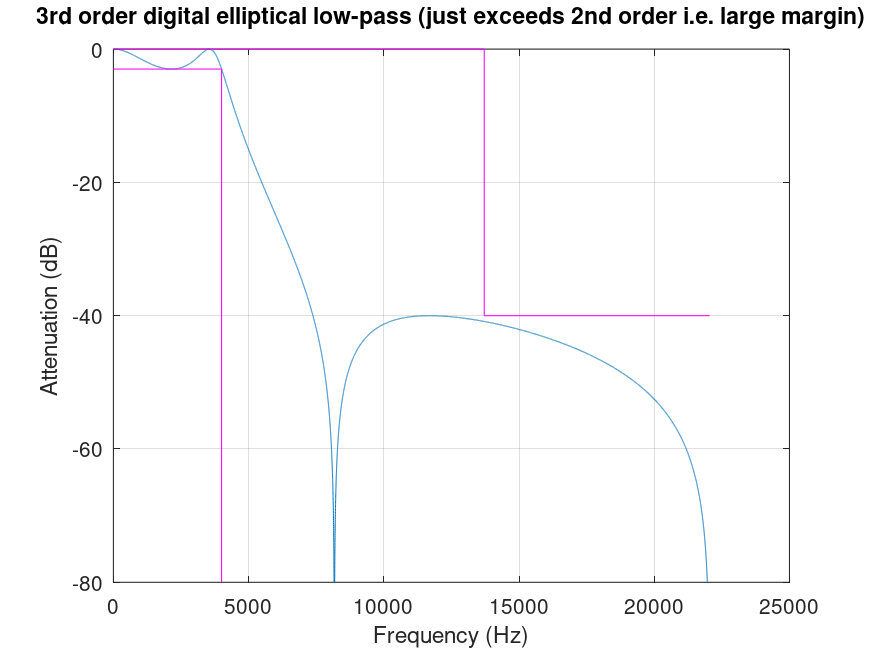 |
Demonstration 3
The following code
fs = 44100;
Npts = fs;
fstop = 4000;
fpass = 13713;
Rpass = 3;
Rstop = 40;
Wpass = 2/fs * fpass;
Wstop = 2/fs * fstop;
[n, Wn] = ellipord (Wpass, Wstop, Rpass, Rstop)
[b, a] = ellip (n, Rpass, Rstop, Wn, "high");
f = 0:fs/2;
W = f * (2 * pi / fs);
H = freqz (b, a, W);
plot (f, 20 * log10 (abs (H)));
outline_hp_pass_x = [fpass(1), fpass(1), max(f)];
outline_hp_pass_y = [-80 , -Rpass , -Rpass];
outline_hp_stop_x = [min(f) , fstop(1), fstop(1), max(f)];
outline_hp_stop_y = [-Rstop , -Rstop , 0 , 0 ];
hold on
plot (outline_hp_pass_x, outline_hp_pass_y, "m", outline_hp_stop_x, outline_hp_stop_y, "m");
ylim ([-80, 0]);
grid on
xlabel ("Frequency (Hz)");
ylabel ("Attenuation (dB)");
title ("2nd order digital elliptical high-pass (without margin)");
Produces the following output
n = 2 Wn = 0.6219
and the following figure
| Figure 1 |
|---|
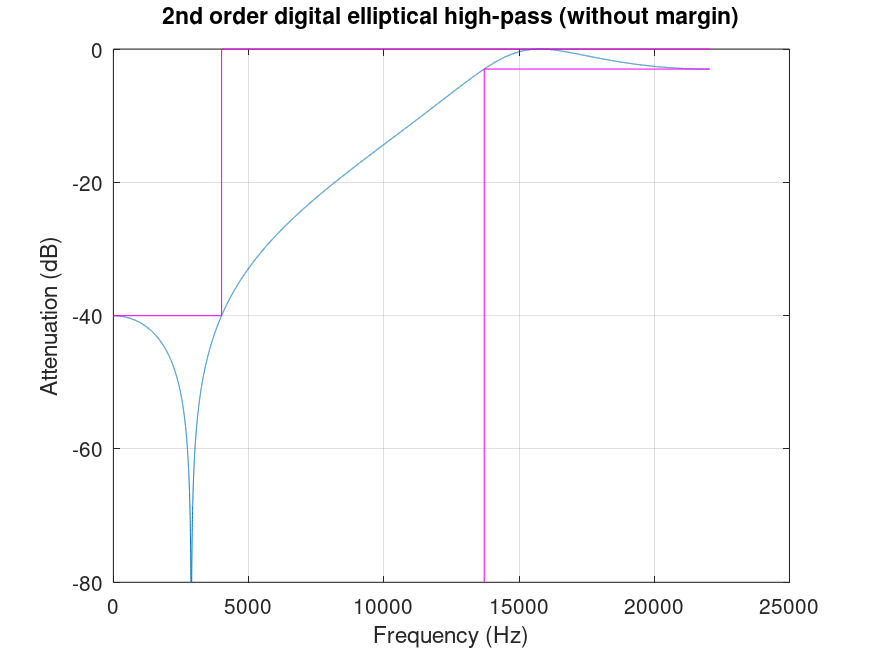 |
Demonstration 4
The following code
fs = 44100;
Npts = fs;
fstop = 4000;
fpass = 13712;
Rpass = 3;
Rstop = 40;
Wpass = 2/fs * fpass;
Wstop = 2/fs * fstop;
[n, Wn] = ellipord (Wpass, Wstop, Rpass, Rstop)
[b, a] = ellip (n, Rpass, Rstop, Wn, "high");
f = 0:fs/2;
W = f * (2 * pi / fs);
H = freqz (b, a, W);
plot (f, 20 * log10 (abs (H)));
outline_hp_pass_x = [fpass(1), fpass(1), max(f)];
outline_hp_pass_y = [-80 , -Rpass , -Rpass];
outline_hp_stop_x = [min(f) , fstop(1), fstop(1), max(f)];
outline_hp_stop_y = [-Rstop , -Rstop , 0 , 0 ];
hold on
plot (outline_hp_pass_x, outline_hp_pass_y, "m", outline_hp_stop_x, outline_hp_stop_y, "m");
ylim ([-80, 0]);
grid on
xlabel ("Frequency (Hz)");
ylabel ("Attenuation (dB)");
title ("3rd order digital elliptical high-pass (just exceeds 2nd order i.e. large margin)");
Produces the following output
n = 3 Wn = 0.6219
and the following figure
| Figure 1 |
|---|
 |
Demonstration 5
The following code
fs = 44100;
Npts = fs;
fpass = [9500 9750];
fstop = [8500 10261];
Rpass = 3;
Rstop = 40;
Wpass = 2/fs * fpass;
Wstop = 2/fs * fstop;
[n, Wn] = ellipord (Wpass, Wstop, Rpass, Rstop)
[b, a] = ellip (n, Rpass, Rstop, Wn);
f = 5000:15000;
W = f * (2 * pi / fs);
H = freqz (b, a, W);
plot (f, 20 * log10 (abs (H)))
outline_bp_pass_x = [fpass(1), fpass(1), fpass(2), fpass(2)];
outline_bp_pass_y = [-80 , -Rpass , -Rpass , -80];
outline_bp_stop_x = [min(f) , fstop(1), fstop(1), fstop(2), fstop(2), max(f)];
outline_bp_stop_y = [-Rstop , -Rstop , 0 , 0 , -Rstop , -Rstop];
hold on
plot (outline_bp_pass_x, outline_bp_pass_y, "m", outline_bp_stop_x, outline_bp_stop_y, "m")
xlim ([f(1), f(end)]);
ylim ([-80, 0]);
grid on
xlabel ("Frequency (Hz)");
ylabel ("Attenuation (dB)");
title ("4th order digital elliptical band-pass (without margin) limitation on upper freq");
Produces the following output
n = 2 Wn = 0.4308 0.4422
and the following figure
| Figure 1 |
|---|
 |
Demonstration 6
The following code
fs = 44100;
Npts = fs;
fpass = [9500 9750];
fstop = [9000 10700];
Rpass = 3;
Rstop = 40;
Wpass = 2/fs * fpass;
Wstop = 2/fs * fstop;
[n, Wn] = ellipord (Wpass, Wstop, Rpass, Rstop)
[b, a] = ellip (n, Rpass, Rstop, Wn);
f = 5000:15000;
W = f * (2 * pi / fs);
H = freqz (b, a, W);
plot (f, 20 * log10 (abs (H)))
outline_bp_pass_x = [fpass(1), fpass(1), fpass(2), fpass(2)];
outline_bp_pass_y = [-80 , -Rpass , -Rpass , -80];
outline_bp_stop_x = [min(f) , fstop(1), fstop(1), fstop(2), fstop(2), max(f)];
outline_bp_stop_y = [-Rstop , -Rstop , 0 , 0 , -Rstop , -Rstop];
hold on
plot (outline_bp_pass_x, outline_bp_pass_y, "m", outline_bp_stop_x, outline_bp_stop_y, "m")
xlim ([f(1), f(end)]);
ylim ([-80, 0]);
grid on
xlabel ("Frequency (Hz)");
ylabel ("Attenuation (dB)");
title ("4th order digital elliptical band-pass (without margin) limitation on lower freq");
Produces the following output
n = 2 Wn = 0.4308 0.4422
and the following figure
| Figure 1 |
|---|
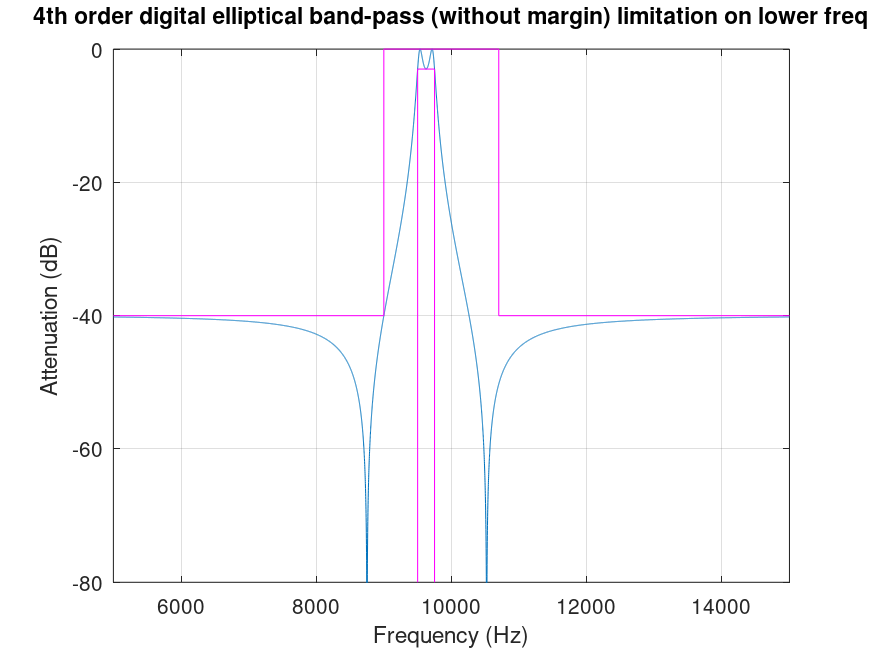 |
Demonstration 7
The following code
fs = 44100;
Npts = fs;
fpass = [9500 9750];
fstop = [8500 10260];
Rpass = 3;
Rstop = 40;
Wpass = 2/fs * fpass;
Wstop = 2/fs * fstop;
[n, Wn] = ellipord (Wpass, Wstop, Rpass, Rstop)
[b, a] = ellip (n, Rpass, Rstop, Wn);
f = 5000:15000;
W = f * (2 * pi / fs);
H = freqz (b, a, W);
plot (f, 20 * log10 (abs (H)))
outline_bp_pass_x = [fpass(1), fpass(1), fpass(2), fpass(2)];
outline_bp_pass_y = [-80 , -Rpass , -Rpass , -80];
outline_bp_stop_x = [min(f) , fstop(1), fstop(1), fstop(2), fstop(2), max(f)];
outline_bp_stop_y = [-Rstop , -Rstop , 0 , 0 , -Rstop , -Rstop];
hold on
plot (outline_bp_pass_x, outline_bp_pass_y, "m", outline_bp_stop_x, outline_bp_stop_y, "m")
xlim ([f(1), f(end)]);
ylim ([-80, 0]);
grid on
xlabel ("Frequency (Hz)");
ylabel ("Attenuation (dB)");
title ("6th order digital elliptical band-pass (just exceeds 4th order i.e. large margin) limitation on upper freq");
Produces the following output
n = 3 Wn = 0.4308 0.4422
and the following figure
| Figure 1 |
|---|
 |
Demonstration 8
The following code
fs = 44100;
Npts = fs;
fpass = [9500 9750];
fstop = [9001 10700];
Rpass = 3;
Rstop = 40;
Wpass = 2/fs * fpass;
Wstop = 2/fs * fstop;
[n, Wn] = ellipord (Wpass, Wstop, Rpass, Rstop)
[b, a] = ellip (n, Rpass, Rstop, Wn);
f = 5000:15000;
W = f * (2 * pi / fs);
H = freqz (b, a, W);
plot (f, 20 * log10 (abs (H)))
outline_bp_pass_x = [fpass(1), fpass(1), fpass(2), fpass(2)];
outline_bp_pass_y = [-80 , -Rpass , -Rpass , -80];
outline_bp_stop_x = [min(f) , fstop(1), fstop(1), fstop(2), fstop(2), max(f)];
outline_bp_stop_y = [-Rstop , -Rstop , 0 , 0 , -Rstop , -Rstop];
hold on
plot (outline_bp_pass_x, outline_bp_pass_y, "m", outline_bp_stop_x, outline_bp_stop_y, "m")
xlim ([f(1), f(end)]);
ylim ([-80, 0]);
grid on
xlabel ("Frequency (Hz)");
ylabel ("Attenuation (dB)");
title ("6th order digital elliptical band-pass (just exceeds 4th order i.e. large margin) limitation on lower freq");
Produces the following output
n = 3 Wn = 0.4308 0.4422
and the following figure
| Figure 1 |
|---|
 |
Demonstration 9
The following code
fs = 44100;
Npts = fs;
fstop = [9875 10126.5823];
fpass = [8500 11073];
Rpass = 0.5;
Rstop = 40;
Wpass = 2/fs * fpass;
Wstop = 2/fs * fstop;
[n, Wn] = ellipord (Wpass, Wstop, Rpass, Rstop)
[b, a] = ellip (n, Rpass, Rstop, Wn, "stop");
f = 5000:15000;
W = f * (2 * pi / fs);
H = freqz (b, a, W);
plot (f, 20 * log10 (abs (H)))
outline_notch_pass_x_a = [min(f) , fpass(1), fpass(1)];
outline_notch_pass_x_b = [fpass(2), fpass(2), max(f)];
outline_notch_pass_y_a = [-Rpass , -Rpass , -80];
outline_notch_pass_y_b = [-80 , -Rpass , -Rpass];
outline_notch_stop_x = [min(f) , fstop(1), fstop(1), fstop(2), fstop(2), max(f)];
outline_notch_stop_y = [0 , 0 , -Rstop , -Rstop , 0 , 0 ];
hold on
plot (outline_notch_pass_x_a, outline_notch_pass_y_a, "m", outline_notch_pass_x_b, outline_notch_pass_y_b, "m", outline_notch_stop_x, outline_notch_stop_y, "m")
xlim ([f(1), f(end)]);
ylim ([-80, 0]);
grid on
xlabel ("Frequency (Hz)");
ylabel ("Attenuation (dB)");
title ("4th order digital elliptical notch (without margin) limit on upper freq");
Produces the following output
n = 2 Wn = 0.4060 0.5022
and the following figure
| Figure 1 |
|---|
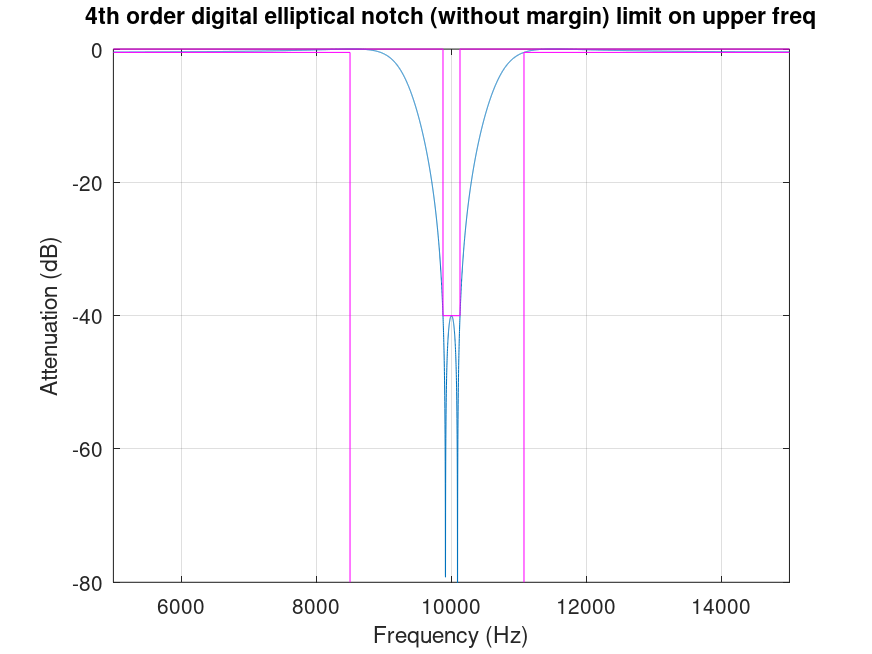 |
Demonstration 10
The following code
fs = 44100;
Npts = fs;
fstop = [9875 10126.5823];
fpass = [8952 12000];
Rpass = 0.5;
Rstop = 40;
Wpass = 2/fs * fpass;
Wstop = 2/fs * fstop;
[n, Wn] = ellipord (Wpass, Wstop, Rpass, Rstop)
[b, a] = ellip (n, Rpass, Rstop, Wn, "stop");
f = 5000:15000;
W = f * (2 * pi / fs);
H = freqz (b, a, W);
plot (f, 20 * log10 (abs (H)))
outline_notch_pass_x_a = [min(f) , fpass(1), fpass(1)];
outline_notch_pass_x_b = [fpass(2), fpass(2), max(f)];
outline_notch_pass_y_a = [-Rpass , -Rpass , -80];
outline_notch_pass_y_b = [-80 , -Rpass , -Rpass];
outline_notch_stop_x = [min(f) , fstop(1), fstop(1), fstop(2), fstop(2), max(f)];
outline_notch_stop_y = [0 , 0 , -Rstop , -Rstop , 0 , 0 ];
hold on
plot (outline_notch_pass_x_a, outline_notch_pass_y_a, "m", outline_notch_pass_x_b, outline_notch_pass_y_b, "m", outline_notch_stop_x, outline_notch_stop_y, "m")
xlim ([f(1), f(end)]);
ylim ([-80, 0]);
grid on
xlabel ("Frequency (Hz)");
ylabel ("Attenuation (dB)");
title ("4th order digital elliptical notch (without margin) limit on lower freq");
Produces the following output
n = 2 Wn = 0.4060 0.5022
and the following figure
| Figure 1 |
|---|
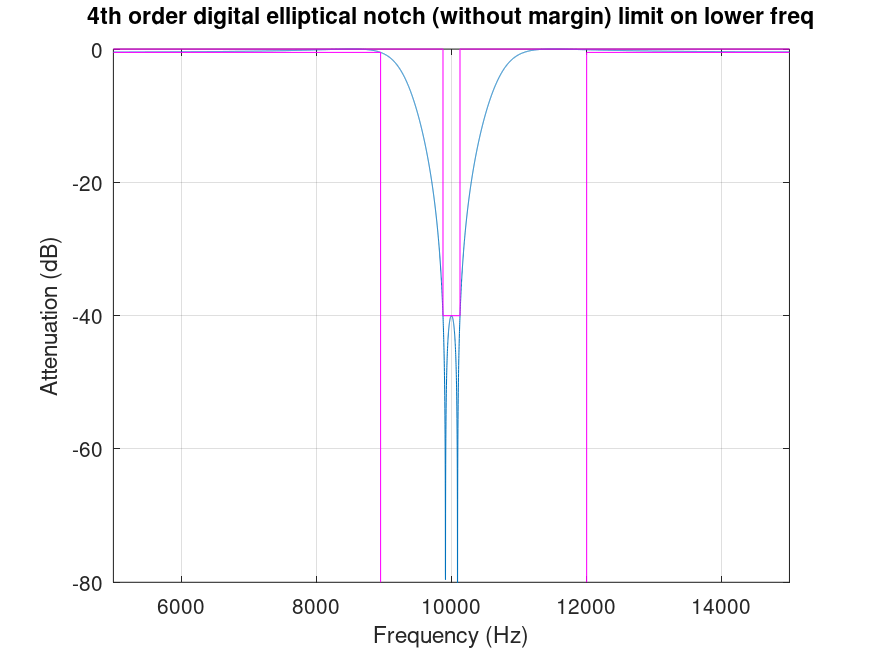 |
Demonstration 11
The following code
fs = 44100;
Npts = fs;
fstop = [9875 10126.5823];
fpass = [8500 11072];
Rpass = 0.5;
Rstop = 40;
Wpass = 2/fs * fpass;
Wstop = 2/fs * fstop;
[n, Wn] = ellipord (Wpass, Wstop, Rpass, Rstop)
[b, a] = ellip (n, Rpass, Rstop, Wn, "stop");
f = 5000:15000;
W = f * (2 * pi / fs);
H = freqz (b, a, W);
plot (f, 20 * log10 (abs (H)))
outline_notch_pass_x_a = [min(f) , fpass(1), fpass(1)];
outline_notch_pass_x_b = [fpass(2), fpass(2), max(f)];
outline_notch_pass_y_a = [-Rpass , -Rpass , -80];
outline_notch_pass_y_b = [-80 , -Rpass , -Rpass];
outline_notch_stop_x = [min(f) , fstop(1), fstop(1), fstop(2), fstop(2), max(f)];
outline_notch_stop_y = [0 , 0 , -Rstop , -Rstop , 0 , 0 ];
hold on
plot (outline_notch_pass_x_a, outline_notch_pass_y_a, "m", outline_notch_pass_x_b, outline_notch_pass_y_b, "m", outline_notch_stop_x, outline_notch_stop_y, "m")
xlim ([f(1), f(end)]);
ylim ([-80, 0]);
grid on
xlabel ("Frequency (Hz)");
ylabel ("Attenuation (dB)");
title ("6th order digital elliptical notch (just exceeds 4th order) limit on upper freq");
Produces the following output
n = 3 Wn = 0.4060 0.5021
and the following figure
| Figure 1 |
|---|
 |
Demonstration 12
The following code
fs = 44100;
Npts = fs;
fstop = [9875 10126.5823];
fpass = [8953 12000];
Rpass = 0.5;
Rstop = 40;
Wpass = 2/fs * fpass;
Wstop = 2/fs * fstop;
[n, Wn] = ellipord (Wpass, Wstop, Rpass, Rstop)
[b, a] = ellip (n, Rpass, Rstop, Wn, "stop");
f = 5000:15000;
W = f * (2 * pi / fs);
H = freqz (b, a, W);
plot (f, 20 * log10 (abs (H)))
outline_notch_pass_x_a = [min(f) , fpass(1), fpass(1)];
outline_notch_pass_x_b = [fpass(2), fpass(2), max(f)];
outline_notch_pass_y_a = [-Rpass , -Rpass , -80];
outline_notch_pass_y_b = [-80 , -Rpass , -Rpass];
outline_notch_stop_x = [min(f) , fstop(1), fstop(1), fstop(2), fstop(2), max(f)];
outline_notch_stop_y = [0 , 0 , -Rstop , -Rstop , 0 , 0 ];
hold on
plot (outline_notch_pass_x_a, outline_notch_pass_y_a, "m", outline_notch_pass_x_b, outline_notch_pass_y_b, "m", outline_notch_stop_x, outline_notch_stop_y, "m")
xlim ([f(1), f(end)]);
ylim ([-80, 0]);
grid on
xlabel ("Frequency (Hz)");
ylabel ("Attenuation (dB)");
title ("6th order digital elliptical notch (just exceeds 4th order) limit on lower freq");
Produces the following output
n = 3 Wn = 0.4060 0.5021
and the following figure
| Figure 1 |
|---|
 |
Demonstration 13
The following code
fpass = 4000;
fstop = 20224;
Rpass = 3;
Rstop = 40;
Wpass = 2*pi * fpass;
Wstop = 2*pi * fstop;
[n, Wn] = ellipord (Wpass, Wstop, Rpass, Rstop, "s")
[b, a] = ellip (n, Rpass, Rstop, Wn, "s");
f = 1000:10:100000;
W = 2*pi * f;
H = freqs (b, a, W);
semilogx(f, 20 * log10 (abs (H)))
outline_lp_pass_x = [f(2) , fpass(1), fpass(1)];
outline_lp_pass_y = [-Rpass, -Rpass , -80];
outline_lp_stop_x = [f(2) , fstop(1), fstop(1), max(f)];
outline_lp_stop_y = [0 , 0 , -Rstop , -Rstop];
hold on
plot (outline_lp_pass_x, outline_lp_pass_y, "m", outline_lp_stop_x, outline_lp_stop_y, "m")
ylim ([-80, 0]);
grid on
xlabel ("Frequency (Hz)");
ylabel ("Attenuation (dB)");
title ("2nd order analog elliptical low-pass (without margin)");
Produces the following output
n = 2 Wn = 2.5133e+04
and the following figure
| Figure 1 |
|---|
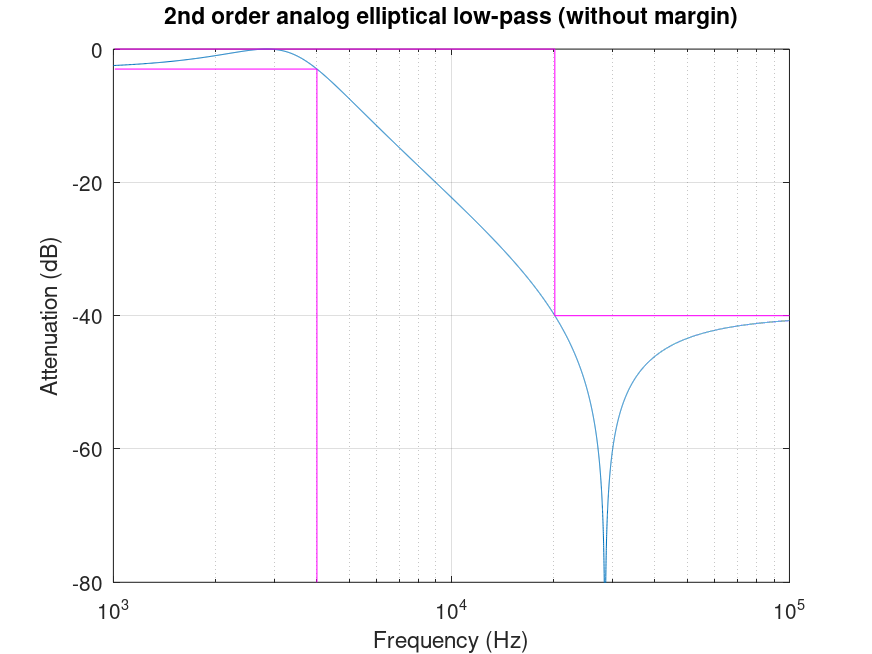 |
Demonstration 14
The following code
fpass = 4000;
fstop = 20223;
Rpass = 3;
Rstop = 40;
Wpass = 2*pi * fpass;
Wstop = 2*pi * fstop;
[n, Wn] = ellipord (Wpass, Wstop, Rpass, Rstop, "s")
[b, a] = ellip (n, Rpass, Rstop, Wn, "s");
f = 1000:10:100000;
W = 2*pi * f;
H = freqs (b, a, W);
semilogx (f, 20 * log10 (abs (H)))
outline_lp_pass_x = [f(2) , fpass(1), fpass(1)];
outline_lp_pass_y = [-Rpass, -Rpass , -80];
outline_lp_stop_x = [f(2) , fstop(1), fstop(1), max(f)];
outline_lp_stop_y = [0 , 0 , -Rstop , -Rstop];
hold on
plot (outline_lp_pass_x, outline_lp_pass_y, "m", outline_lp_stop_x, outline_lp_stop_y, "m")
ylim ([-80, 0]);
grid on
xlabel ("Frequency (Hz)");
ylabel ("Attenuation (dB)");
title ("3rd order analog elliptical low-pass (just exceeds 2nd order i.e. large margin)");
Produces the following output
n = 3 Wn = 2.5133e+04
and the following figure
| Figure 1 |
|---|
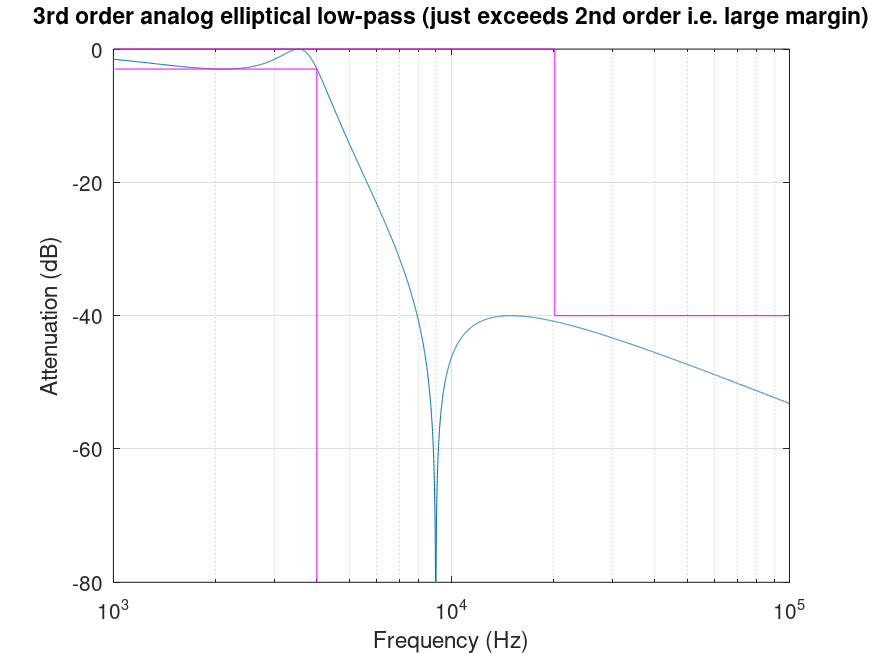 |
Demonstration 15
The following code
fstop = 4000;
fpass = 20224;
Rpass = 3;
Rstop = 40;
Wpass = 2*pi * fpass;
Wstop = 2*pi * fstop;
[n, Wn] = ellipord (Wpass, Wstop, Rpass, Rstop, "s")
[b, a] = ellip (n, Rpass, Rstop, Wn, "high", "s");
f = 1000:10:100000;
W = 2*pi * f;
H = freqs (b, a, W);
semilogx (f, 20 * log10 (abs (H)))
outline_hp_pass_x = [fpass(1), fpass(1), max(f)];
outline_hp_pass_y = [-80 , -Rpass , -Rpass];
outline_hp_stop_x = [f(2) , fstop(1), fstop(1), max(f)];
outline_hp_stop_y = [-Rstop , -Rstop , 0 , 0 ];
hold on
plot (outline_hp_pass_x, outline_hp_pass_y, "m", outline_hp_stop_x, outline_hp_stop_y, "m")
ylim ([-80, 0]);
grid on
xlabel ("Frequency (Hz)");
ylabel ("Attenuation (dB)");
title ("2nd order analog elliptical high-pass (without margin)");
Produces the following output
n = 2 Wn = 1.2707e+05
and the following figure
| Figure 1 |
|---|
 |
Demonstration 16
The following code
fstop = 4000;
fpass = 20223;
Rpass = 3;
Rstop = 40;
Wpass = 2*pi * fpass;
Wstop = 2*pi * fstop;
[n, Wn] = ellipord (Wpass, Wstop, Rpass, Rstop, "s")
[b, a] = ellip (n, Rpass, Rstop, Wn, "high", "s");
f = 1000:10:100000;
W = 2*pi * f;
H = freqs (b, a, W);
semilogx (f, 20 * log10 (abs (H)))
outline_hp_pass_x = [fpass(1), fpass(1), max(f)];
outline_hp_pass_y = [-80 , -Rpass , -Rpass];
outline_hp_stop_x = [f(2) , fstop(1), fstop(1), max(f)];
outline_hp_stop_y = [-Rstop , -Rstop , 0 , 0 ];
hold on
plot (outline_hp_pass_x, outline_hp_pass_y, "m", outline_hp_stop_x, outline_hp_stop_y, "m")
ylim ([-80, 0]);
grid on
xlabel ("Frequency (Hz)");
ylabel ("Attenuation (dB)");
title ("3rd order analog elliptical high-pass (just exceeds 2nd order i.e. large margin)");
Produces the following output
n = 3 Wn = 1.2706e+05
and the following figure
| Figure 1 |
|---|
 |
Demonstration 17
The following code
fpass = [9875 10126.5823];
fstop = [9000 10657];
Rpass = 3;
Rstop = 40;
fcenter = sqrt (fpass(1) * fpass(2));
Wpass = 2*pi * fpass;
Wstop = 2*pi * fstop;
[n, Wn] = ellipord (Wpass, Wstop, Rpass, Rstop, "s")
[b, a] = ellip (n, Rpass, Rstop, Wn, "s");
f = 5000:15000;
W = 2*pi * f;
H = freqs (b, a, W);
plot (f, 20 * log10 (abs (H)))
outline_bp_pass_x = [fpass(1), fpass(1), fpass(2), fpass(2)];
outline_bp_pass_y = [-80 , -Rpass , -Rpass , -80];
outline_bp_stop_x = [f(2) , fstop(1), fstop(1), fstop(2), fstop(2), max(f)];
outline_bp_stop_y = [-Rstop , -Rstop , 0 , 0 , -Rstop , -Rstop];
hold on
plot (outline_bp_pass_x, outline_bp_pass_y, "m", outline_bp_stop_x, outline_bp_stop_y, "m")
xlim ([f(1), f(end)]);
ylim ([-80, 0]);
grid on
xlabel ("Frequency (Hz)");
ylabel ("Attenuation (dB)");
title ("4th order analog elliptical band-pass (without margin) limitation on upper freq");
Produces the following output
n = 2 Wn = 6.2046e+04 6.3627e+04
and the following figure
| Figure 1 |
|---|
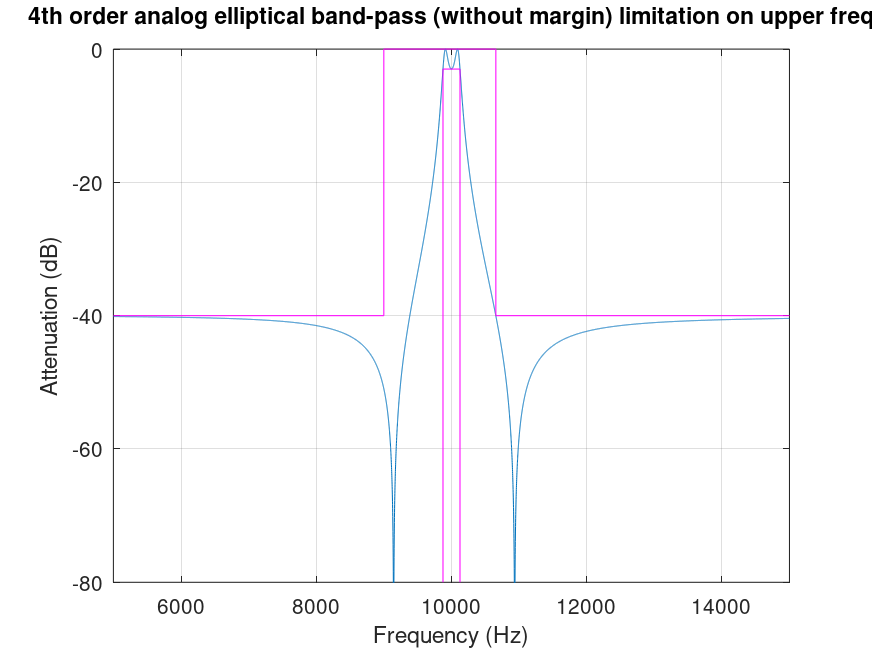 |
Demonstration 18
The following code
fpass = [9875 10126.5823];
fstop = [9384 12000];
Rpass = 3;
Rstop = 40;
fcenter = sqrt (fpass(1) * fpass(2));
Wpass = 2*pi * fpass;
Wstop = 2*pi * fstop;
[n, Wn] = ellipord (Wpass, Wstop, Rpass, Rstop, "s")
[b, a] = ellip (n, Rpass, Rstop, Wn, "s");
f = 5000:15000;
W = 2*pi * f;
H = freqs (b, a, W);
plot (f, 20 * log10 (abs (H)))
outline_bp_pass_x = [fpass(1), fpass(1), fpass(2), fpass(2)];
outline_bp_pass_y = [-80 , -Rpass , -Rpass , -80];
outline_bp_stop_x = [f(2) , fstop(1), fstop(1), fstop(2), fstop(2), max(f)];
outline_bp_stop_y = [-Rstop , -Rstop , 0 , 0 , -Rstop , -Rstop];
hold on
plot (outline_bp_pass_x, outline_bp_pass_y, "m", outline_bp_stop_x, outline_bp_stop_y, "m")
xlim ([f(1), f(end)]);
ylim ([-80, 0]);
grid on
xlabel ("Frequency (Hz)");
ylabel ("Attenuation (dB)");
title ("4th order analog elliptical band-pass (without margin) limitation on lower freq");
Produces the following output
n = 2 Wn = 6.2046e+04 6.3627e+04
and the following figure
| Figure 1 |
|---|
 |
Demonstration 19
The following code
fpass = [9875 10126.5823];
fstop = [9000 10656];
Rpass = 3;
Rstop = 40;
fcenter = sqrt (fpass(1) * fpass(2));
Wpass = 2*pi * fpass;
Wstop = 2*pi * fstop;
[n, Wn] = ellipord (Wpass, Wstop, Rpass, Rstop, "s")
[b, a] = ellip (n, Rpass, Rstop, Wn, "s");
f = 5000:15000;
W = 2*pi * f;
H = freqs (b, a, W);
plot (f, 20 * log10 (abs (H)))
outline_bp_pass_x = [fpass(1), fpass(1), fpass(2), fpass(2)];
outline_bp_pass_y = [-80 , -Rpass , -Rpass , -80];
outline_bp_stop_x = [f(2) , fstop(1), fstop(1), fstop(2), fstop(2), max(f)];
outline_bp_stop_y = [-Rstop , -Rstop , 0 , 0 , -Rstop , -Rstop];
hold on
plot (outline_bp_pass_x, outline_bp_pass_y, "m", outline_bp_stop_x, outline_bp_stop_y, "m")
xlim ([f(1), f(end)]);
ylim ([-80, 0]);
grid on
xlabel ("Frequency (Hz)");
ylabel ("Attenuation (dB)");
title ("6th order analog elliptical band-pass (just exceeds 4th order i.e. large margin) limitation on upper freq");
Produces the following output
n = 3 Wn = 6.2046e+04 6.3627e+04
and the following figure
| Figure 1 |
|---|
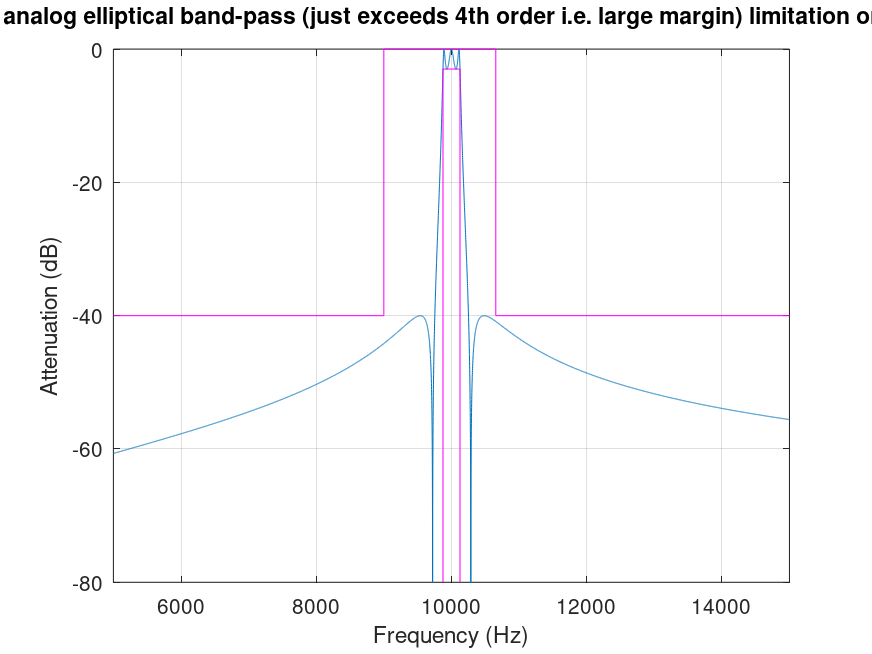 |
Demonstration 20
The following code
fpass = [9875 10126.5823];
fstop = [9385 12000];
Rpass = 3;
Rstop = 40;
fcenter = sqrt (fpass(1) * fpass(2));
Wpass = 2*pi * fpass;
Wstop = 2*pi * fstop;
[n, Wn] = ellipord (Wpass, Wstop, Rpass, Rstop, "s")
[b, a] = ellip (n, Rpass, Rstop, Wn, "s");
f = 5000:15000;
W = 2*pi * f;
H = freqs (b, a, W);
plot (f, 20 * log10 (abs (H)))
outline_bp_pass_x = [fpass(1), fpass(1), fpass(2), fpass(2)];
outline_bp_pass_y = [-80 , -Rpass , -Rpass , -80];
outline_bp_stop_x = [f(2) , fstop(1), fstop(1), fstop(2), fstop(2), max(f)];
outline_bp_stop_y = [-Rstop , -Rstop , 0 , 0 , -Rstop , -Rstop];
hold on
plot (outline_bp_pass_x, outline_bp_pass_y, "m", outline_bp_stop_x, outline_bp_stop_y, "m")
xlim ([f(1), f(end)]);
ylim ([-80, 0]);
grid on
xlabel ("Frequency (Hz)");
ylabel ("Attenuation (dB)");
title ("6th order analog elliptical band-pass (just exceeds 4th order i.e. large margin) limitation on lower freq");
Produces the following output
n = 3 Wn = 6.2046e+04 6.3627e+04
and the following figure
| Figure 1 |
|---|
 |
Demonstration 21
The following code
fstop = [9875 10126.5823];
fpass = [9000 10657];
Rpass = 3;
Rstop = 40;
fcenter = sqrt (fpass(1) * fpass(2));
Wpass = 2*pi * fpass;
Wstop = 2*pi * fstop;
[n, Wn] = ellipord (Wpass, Wstop, Rpass, Rstop, "s")
[b, a] = ellip (n, Rpass, Rstop, Wn, "stop", "s");
f = 5000:15000;
W = 2*pi * f;
H = freqs (b, a, W);
plot (f, 20 * log10 (abs (H)))
outline_notch_pass_x_a = [f(2) , fpass(1), fpass(1)];
outline_notch_pass_x_b = [fpass(2), fpass(2), max(f)];
outline_notch_pass_y_a = [-Rpass , -Rpass , -80];
outline_notch_pass_y_b = [-80 , -Rpass , -Rpass];
outline_notch_stop_x = [f(2) , fstop(1), fstop(1), fstop(2), fstop(2), max(f)];
outline_notch_stop_y = [0 , 0 , -Rstop , -Rstop , 0 , 0 ];
hold on
plot (outline_notch_pass_x_a, outline_notch_pass_y_a, "m", outline_notch_pass_x_b, outline_notch_pass_y_b, "m", outline_notch_stop_x, outline_notch_stop_y, "m")
xlim ([f(1), f(end)]);
ylim ([-80, 0]);
grid on
xlabel ("Frequency (Hz)");
ylabel ("Attenuation (dB)");
title ("4th order analog elliptical notch (without margin) limit on upper freq");
Produces the following output
n = 2 Wn = 5.8958e+04 6.6960e+04
and the following figure
| Figure 1 |
|---|
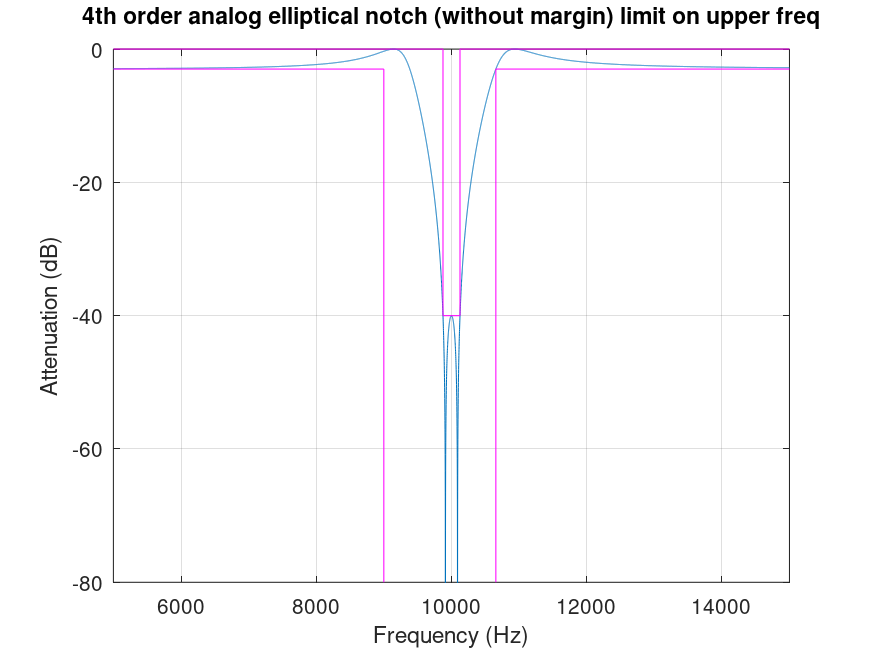 |
Demonstration 22
The following code
fstop = [9875 10126.5823];
fpass = [9384 12000];
Rpass = 3;
Rstop = 40;
fcenter = sqrt (fpass(1) * fpass(2));
Wpass = 2*pi * fpass;
Wstop = 2*pi * fstop;
[n, Wn] = ellipord (Wpass, Wstop, Rpass, Rstop, "s")
[b, a] = ellip (n, Rpass, Rstop, Wn, "stop", "s");
f = 5000:15000;
W = 2*pi * f;
H = freqs (b, a, W);
plot (f, 20 * log10 (abs (H)))
outline_notch_pass_x_a = [f(2) , fpass(1), fpass(1)];
outline_notch_pass_x_b = [fpass(2), fpass(2), max(f)];
outline_notch_pass_y_a = [-Rpass , -Rpass , -80];
outline_notch_pass_y_b = [-80 , -Rpass , -Rpass];
outline_notch_stop_x = [f(2) , fstop(1), fstop(1), fstop(2), fstop(2), max(f)];
outline_notch_stop_y = [0 , 0 , -Rstop , -Rstop , 0 , 0 ];
hold on
plot (outline_notch_pass_x_a, outline_notch_pass_y_a, "m", outline_notch_pass_x_b, outline_notch_pass_y_b, "m", outline_notch_stop_x, outline_notch_stop_y, "m")
xlim ([f(1), f(end)]);
ylim ([-80, 0]);
grid on
xlabel ("Frequency (Hz)");
ylabel ("Attenuation (dB)");
title ("4th order analog elliptical notch (without margin) limit on lower freq");
Produces the following output
n = 2 Wn = 5.8961e+04 6.6956e+04
and the following figure
| Figure 1 |
|---|
 |
Demonstration 23
The following code
fstop = [9875 10126.5823];
fpass = [9000 10656];
Rpass = 3;
Rstop = 40;
fcenter = sqrt (fpass(1) * fpass(2));
Wpass = 2*pi * fpass;
Wstop = 2*pi * fstop;
[n, Wn] = ellipord (Wpass, Wstop, Rpass, Rstop, "s")
[b, a] = ellip (n, Rpass, Rstop, Wn, "stop", "s");
f = 5000:15000;
W = 2*pi * f;
H = freqs (b, a, W);
plot (f, 20 * log10 (abs (H)))
outline_notch_pass_x_a = [f(2) , fpass(1), fpass(1)];
outline_notch_pass_x_b = [fpass(2), fpass(2), max(f)];
outline_notch_pass_y_a = [-Rpass , -Rpass , -80];
outline_notch_pass_y_b = [-80 , -Rpass , -Rpass];
outline_notch_stop_x = [f(2) , fstop(1), fstop(1), fstop(2), fstop(2), max(f)];
outline_notch_stop_y = [0 , 0 , -Rstop , -Rstop , 0 , 0 ];
hold on
plot (outline_notch_pass_x_a, outline_notch_pass_y_a, "m", outline_notch_pass_x_b, outline_notch_pass_y_b, "m", outline_notch_stop_x, outline_notch_stop_y, "m")
xlim ([f(1), f(end)]);
ylim ([-80, 0]);
grid on
xlabel ("Frequency (Hz)");
ylabel ("Attenuation (dB)");
title ("6th order analog elliptical notch (just exceeds 4th order) limit on upper freq");
Produces the following output
n = 3 Wn = 5.8964e+04 6.6954e+04
and the following figure
| Figure 1 |
|---|
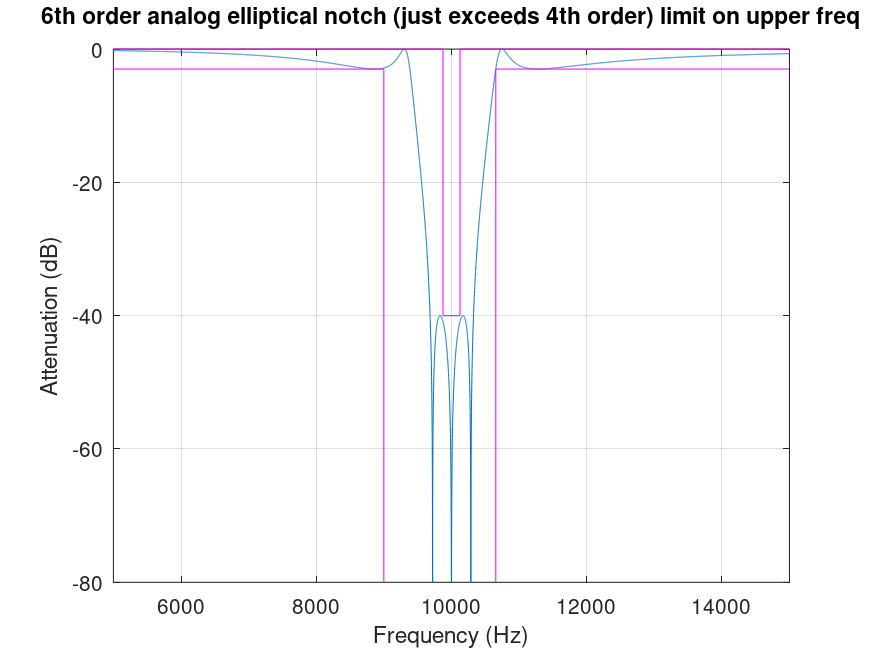 |
Demonstration 24
The following code
fstop = [9875 10126.5823];
fpass = [9385 12000];
Rpass = 3;
Rstop = 40;
fcenter = sqrt (fpass(1) * fpass(2));
Wpass = 2*pi * fpass;
Wstop = 2*pi * fstop;
[n, Wn] = ellipord (Wpass, Wstop, Rpass, Rstop, "s")
[b, a] = ellip (n, Rpass, Rstop, Wn, "stop", "s");
f = 5000:15000;
W = 2*pi * f;
H = freqs (b, a, W);
plot (f, 20 * log10 (abs (H)))
outline_notch_pass_x_a = [f(2) , fpass(1), fpass(1)];
outline_notch_pass_x_b = [fpass(2), fpass(2), max(f)];
outline_notch_pass_y_a = [-Rpass , -Rpass , -80];
outline_notch_pass_y_b = [-80 , -Rpass , -Rpass];
outline_notch_stop_x = [f(2) , fstop(1), fstop(1), fstop(2), fstop(2), max(f)];
outline_notch_stop_y = [0 , 0 , -Rstop , -Rstop , 0 , 0 ];
hold on
plot (outline_notch_pass_x_a, outline_notch_pass_y_a, "m", outline_notch_pass_x_b, outline_notch_pass_y_b, "m", outline_notch_stop_x, outline_notch_stop_y, "m")
xlim ([f(1), f(end)]);
ylim ([-80, 0]);
grid on
xlabel ("Frequency (Hz)");
ylabel ("Attenuation (dB)");
title ("6th order analog elliptical notch (just exceeds 4th order) limit on lower freq");
Produces the following output
n = 3 Wn = 5.8968e+04 6.6949e+04
and the following figure
| Figure 1 |
|---|
 |
Package: signal